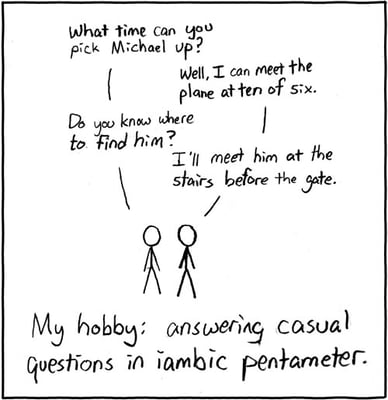 The term iambic pentameter sounds like it’s more at home in a science textbook than it is in your English class. But believe it or not, iambic pentameter is a type of poetic meter!
The term iambic pentameter sounds like it’s more at home in a science textbook than it is in your English class. But believe it or not, iambic pentameter is a type of poetic meter!
In other words, iambic pentameter is a term that refers to a very specific type of rhythm that you find in poetry.
Knowing what poetic meter is and how to find it is an important skill for the AP Literature exam, and it can be really impressive if you discuss it properly in the AP exam’s essay portion. We know poetic meter might sound scary—heck, anything that has to do with poetry can be scary!—but we’re here to help. In this article, you’ll learn what iambic pentameter is, discover how to find it in a poem, and analyze iambic pentameter examples in poetry.
Let’s dive right in!

"Penta" means "five," so you know there will be five of SOMETHING in iambic pentameter.
(Spoiler alert: it has to do with the number of iambs in each line!)
Iambic Pentameter: Definition and Meaning
To understand iambic pentameter, it’s easiest to break the phrase down into two parts.
Part 1: Pentameter
Let’s start with pentameter. In poetry, meter is the pattern of stressed and unstressed syllables in a verse, or line, of a poem.
Whew! That’s already a lot! Let’s unpack that a little bit. A syllable is the number of vowel sounds that are present in a word. Consonant sounds don’t matter! The more vowel sounds a word has, the more syllables it has! (Quick refresher: vowels are a, e, i, o, u, and sometimes y.) So for example, “question” has two syllables, “flexible” has three syllables, and “do” has one syllable.
Don’t make the mistake of thinking long words must have more syllables than short words! Syllabation has everything to do with the vowel sounds a word has, not the number of letters. For example, the word “screeched” only has one syllable whereas “utopia” has four!
But poetic meter is more than just the number of syllables in a verse: it’s the pattern of stressed and unstressed syllables. So what makes a syllable stressed or unstressed? Well, we’re glad you asked!
A stressed syllable is a syllable that has five tests all on the same day. (Just kidding...but we couldn’t resist a dad joke.) But seriously, a stressed syllable is a syllable that’s emphasized within a word. It’s the syllable that stands out, and it often has a long vowel sound.
Let’s look at a few words to see what we mean. Take “meter,” for example. Meter has two syllables, and the first one is stressed. But when you say “meter,” you pronounce it ME-ter, not me-TER. That’s because the first syllable is stressed. That makes the second syllable—or the one that doesn’t have emphasis—unstressed. Another example is “computer.” In this word, only the middle syllable is stressed. You pronounce it com-PU-ter, not COM-pu-ter or com-pu-TER.
Not all words have stressed syllables! For example, “homemade” has two unstressed syllables. (It would sound silly to say HOME-made or home-MADE.)
Although there are complex ways to determine stressed and unstressed syllables, the easiest way to determine the stressed and unstressed syllables in a line of poetry is to read the verse out loud. You’ll definitely be able to hear if you’re pronouncing a word funny! (In our favorite clip from the movie A View from the Top, Mike Meyers demonstrates this perfectly.)
But what makes a poem have pentameter specifically? Well, a poem with pentameter has five stressed syllables in a line. Here’s an example of a line with pentameter from Shakespeare’s “Sonnet 18.” The line reads, “Sometime too hot the eye of heaven shines.” Okay, so let’s break this line up into syllables by using hyphens instead. If we count the syllables in this line, we end up with 10, and the line would look like this:
Now let’s look at the stressed syllables. In this line, every other syllable is stressed. So when you read it out loud, it sounds like this:
That means the line has five stressed syllables, which tells us that this verse uses pentameter. (And because we know this is a Shakespearean sonnet, we also know that the whole poem will be in pentameter.)
When all of a poem’s lines have the same number of stressed syllables, we say that the poem has meter. Poems can have all kinds of meter. Poems where lines have six stressed syllables in each line are written in “hexameter,” and a poem with three stressed syllables in each line would be in “triameter.” In the case of a poem with pentameter, every single line of the poem will have five stressed syllables in some combination.
 Did you know that poetry has feet? METRICAL feet, that is!
Did you know that poetry has feet? METRICAL feet, that is!
Part 2: Iambs
Now let’s tackle the “iambic” part of iambic pentameter. An iamb is a type of metrical foot in poetry. (A metrical foot is a combination of stressed and unstressed syllables that repeats itself throughout a verse, stanza, or poem.)
An iamb is a very specific type of metrical foot that has one unstressed syllable followed by a stressed syllable. In order to figure this out, it’s best to read the poem out loud. You can underline each part of the word that is a stressed syllable, which will allow you to visualize the pattern. (There are actual, formal marks that linguists and literature scholars use to indicate rhythm and meter, which you can find here if you’re interested.)
Here’s a line from Shakespeare’s “Sonnet 37”: “And by a part of all thy glory live.” Let’s go ahead and break it into its stressed and unstressed syllables, which looks something like this:
See how the stresses alternate with unstressed syllables perfectly? Each pair of unstressed and stressed syllables—like “and/by” and “of/all”—is an iamb. Because each line of this poem uses this alternating structure of unstressed and stressed syllables, we would say that the poem iambic.
 Randall Munroe/xkcd
Randall Munroe/xkcd
Putting It Together: Iambic Pentameter
So now let’s put all of our new knowledge together. If an iamb is a combination of syllables, and meter is a certain number of stressed syllables, then iambic pentameter is a specific arrangement of stressed and unstressed syllables. In iambic pentameter, each line of the poem has to have five iambs!
To see this at work, let’s look at another line from a Shakespearean sonnet, this time from “Sonnet 104.” The line reads, “Have from the forests shook three summers' pride.”
First, let’s break the line down into its syllables using hyphens:
Now, let’s add the stresses into the line by capitalizing each stressed syllable:
Now, let’s count the metrical feet by adding a / in between each piece of the pattern:
Because this line has five feet that each contain an unstressed syllable followed by a stressed syllable, we know that it’s a verse written in iambic pentameter. When the whole poem is written with the same rhythm, we can say that the poem has iambic pentameter, too!
Iambic pentameter is a popular poetic form, especially in English poetry. Many people think of it as the “standard” poetic meter, likely because Shakespeare’s sonnets are all written in iambic pentameter. But some modern poets, like Wallace Stevens and John Keats, use iambic pentameter, too.

Iambic Pentameter in Poetry: “The Waking” by Theodore Roethke
Now that you know what iambic pentameter is, let’s test out your new skills with a poem that wasn’t written by Shakespeare! Let’s take a look at a few stanzas from “The Waking” by Theodore Roethke, one of the most famous poets of the 20th century, which is a good iambic pentameter example. The second stanza reads:
I hear my being dance from ear to ear.
I wake to sleep, and take my waking slow.
Okay, try doing this one on your own. Copy and paste this stanza into your word processor and see if you can break each line into syllables. Then capitalize the stressed syllables. Once that’s done, put a forward slash in between each metrical foot.
Once you’re done, check out the correct meter in the box below:
i HEAR / my BE / ing DANCE / from EAR / to EAR
i WAKE / to SLEEP / and TAKE / my WAK /ing SLOW
See the pattern of iambs (an unstressed followed by a stressed syllable)? Because each line has five iambs, you know the poem is written in iambic pentameter!
Let’s try another iambic pentameter example from the same poem. Here’s the stanza:
To you and me; so take the lively air,
And, lovely, learn by going where to go.
Do the same thing: separate the syllables by a hyphen, then go back and capitalize every syllable that you think is stressed. Here’s the finished mark-up:
to YOU / and ME; / so TAKE / the LIVE / ly AIR,
and, LOVE / ly, LEARN / by GO / ing WHERE / to GO.
Did you get it? We’re sure you did now that you’re an iambic pentameter expert!
If you want some more practice working through iambic pentameter examples, you can repeat this exercise on almost all of Shakespeare's sonnets. (Hey...maybe you can find the ones that aren’t exactly in iambic pentameter, too!) You can find all of Shakespeare's sonnets courtesy of OpenSource Shakespeare.

Now What?
If this post was helpful and you want to learn more about how to analyze literature and poetry, check out our step-by-step analysis of Tom Buchanan from The Great Gatsby.
Studying for the AP Literature exam already? Here’s the ultimate AP literature reading list that will help you ace your AP exam.
There are two AP English tests: the AP Literature exam and the AP Language & Composition exam. Learn more about the AP Language & Composition test and how it differs from its literary equivalent here.











